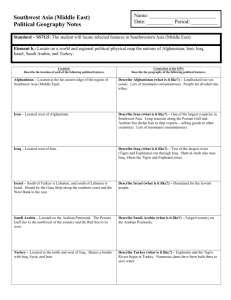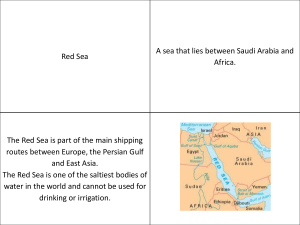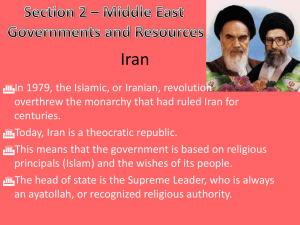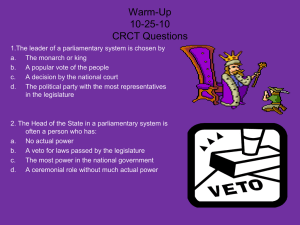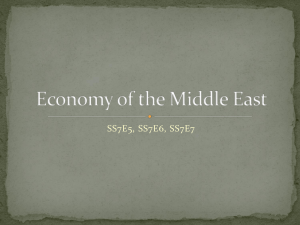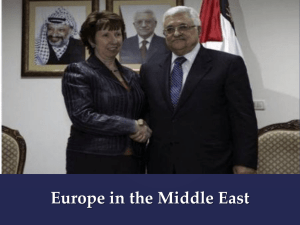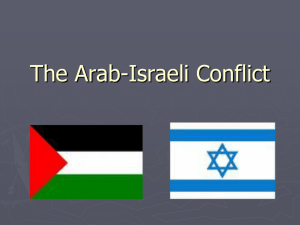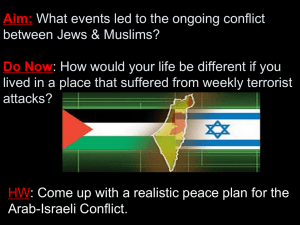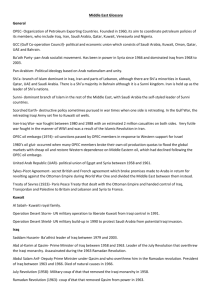North Africa and Southwest Asia
advertisement
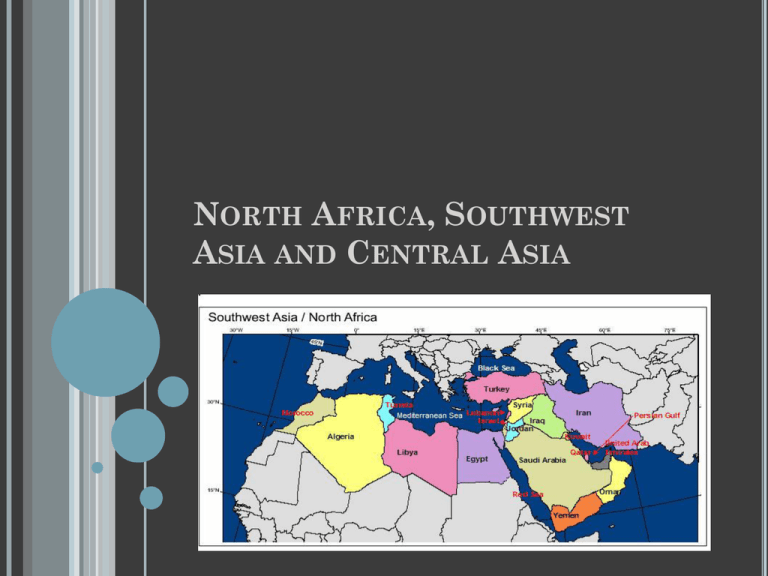
NORTH AFRICA, SOUTHWEST ASIA AND CENTRAL ASIA WHAT MAKES THIS A REGION? I. II. III. IV. V. Deserts and Mountains Population that practices one of the three major monotheistic religions Possession of more than half of the worlds known oil reserves A need for freshwater resources A history of external cultural influences PHYSICAL GEOGRAPHY Tectonic activity responsible for shaping landscape 4 tectonic plates converge in this region Shifting plates have built mountains and frequently cause earthquakes Atlas mountains are found in North Africa Precipitation on northern side of mountains makes this an agriculturally productive region Along the coast of the Arabian Peninsula two mountain ranges, Hejaz and Asir, Asir region the most agriculturally productive region in Southwest Asia Caucus Mountains are found between the Caspian and Black Seas PHYSICAL GEOGRAPHY Coastal Plains are the most fertile regions and support agriculture Major peninsulas- Arabian, Sinai, Anatolian Landlocked bodies of saltwater are found in the region Caspian Sea- largest inland body of water on Earth Dead Sea on the border of Israel and Jordan is at the mouth of the Jordan River Aral Sea in Central Asia 1960’s fourth largest body of water in the world Dried up in the 1970’s to present because of water used for irrigation to grow cotton, split the sea north and south PHYSICAL GEOGRAPHY Water Systems Region lacks abundant water resources and rivers have always been important and affected development Nile River fertile land along river home to one of the worlds earliest civilizations 90% of population lives in Nile River delta (3% of Egypt’s land) Aswan High Dam on Nile provides hydroelectric power and water for agriculture Tigris- Euphrates valley in Southwest Asia was a cradle of civilization Today dams provide water for agriculture and hydroelectric power for Syria, Iraq and Turkey PHYSICAL GEOGRAPHY Oil and natural gas are the most important natural resources in the region Region contains over 60% of the know world oil reserves Oil exports have enriched the region Economy can rise or sink because of fluctuation in world oil markets Many countries in the region are trying to diversify their economies away from reliance on oil exports CLIMATE Water scarcity affects the regions climate Deserts cover more than 50% of the region Sahara Desert largest desert in the world, covers North Africa Weather patterns in deserts are extreme, cold nights and long hot summers Rub al-Khali in Saudi Arabia largest area of sand in the world Some nomadic herding and small scale farming is possible in oasis regions Villages develop around oases CLIMATE Steppe is the second largest climate region Supports livestock grazing Mediterranean climates are found in coastal areas Countries rely on Mediterranean climates to export citrus fruits, olives to Europe and North America These regions also benefit from tourism CULTURAL GEOGRAPHY NORTH AFRICA Indigenous cultures of North Africa have mixed with Arab and European cultures Spanish, French, Roman, Jewish and Muslim cultures have influenced the region European influence mainly in coastal North Arica (Morocco, Algeria, Tunisia) Primary cultural mixture is Arab and indigenous cultures Arab invaders mixed with native Berber people Berbers exist today as farmers and pastoral nomads Arabs migrated to the region around 600 NORTH AFRICA Availability of water has influenced settlement Most people settled along seacoasts and river deltas Cairo, Egypt is one of the most densely populated cities on the planet NORTH AFRICA Location near Europe and Southwest Asia has made the region vulnerable to invasion over the centuries Regions farmers were among the first in the world to domesticate plants and animals One of the world first great civilizations developed in the Nile River Valley In the 600’s Arab invasions and heavily influenced cultures of the region The Arabs brought their language, architecture and Islam European colonial influence in the 1800’s helped develop the regions geometric boundaries NORTH AFRICA Egypt gained independence in 1922 from Great Britain Typically pro- Western in their views, country has a large military Their control of the Suez canal has made it a key regional power Egypt is also a center of Arab nationalism Algeria gained independence from France in 1962 They have developed their natural resources (oil) and raised their standard of living Libya gained independence from Italy in 1951 Since 1969 they have been ruled by a military dictator Muammar Kaddafi Morocco and Tunisia gained independence from France in 1956 NORTH AFRICA Most people in North Africa practice Islam Most share the Arabic language Literacy rates range widely from 52% in Morocco to 82% in Libya Health care is government run in most countries, with urban areas receiving better health care than rural areas EASTERN MEDITERRANEAN Region is inhabited by Jews and Arabs Most Jews live in Israel Trace heritage to region that is today Israel and Lebanon Invasions led to exile and persecution, forced many Jews to relocate to different countries 1948 Israel founded as an independent Jewish state Arabs in region did not want Jewish state that had been their homeland for centuries, brought a series of six wars to the region sine 1948 Palestinians are the Arab people that live where Israel is today Many have been displaced from their homes and have been forced to become refugees EASTERN MEDITERRANEAN Countries in the region include: Israel, Jordan, Syria, Lebanon Dry desert climate of the region causes majority of population to live along coasts and Euphrates River Valley Parts of region have highest population densities in the region Eastern Mediterranean is 75% urban People from over 100 countries have settled in Israel, makes an ethnically diverse country EASTERN MEDITERRANEAN Three major religions began in region Judaism, Christianity, and Islam All three share similar beliefs, especially monotheism Judaism is the oldest of the monotheistic faiths Christianity was founded in the land of Israel in AD 30 Islamic tradition began on nearby Arabian peninsula and spread to the region by AD 700 EASTERN MEDITERRANEAN Jews in the late 1800’s called Zionists , called for a return to Palestine and the foundation of a Jewish state After WWII the UN divided Palestine into a Jewish state and an Arab state 1948 Jews proclaim the independent state of Israel Series of wars occurred over the next 50 years and caused many Palestinians to become refugees Many Palestinians today live in Israeli controlled settlements in Israel Palestinians want an independent state of their own Israel agreed to give the Palestinians some self rule in the 1990’s, but have since changed their position The militant Palestinians group Hamas has supported attacks on Israeli territory EASTERN MEDITERRANEAN Most people in are Muslim Large groups of Christians live in Syria and Lebanon Hebrew is spoken in Israel, while other countries speak Arabic Literacy rates vary from 76% in Syria to 96% in Israel IRAN, IRAQ AND TURKEY Ethnic Populations Turks- migrated from Central Asia Eventually became known as the Ottomans and ruled the region for 600 years Most Turks practice Sunni Islam Iranians- migrated from Central Asia Speak Farsi 90% practice Shia branch of Islam Arabs- majority of people in Iraq Most are Shia Muslims Arabic is the most commonly spoken language Kurds- live in mountainous border area of Turkey and Iraq Most are Sunni Muslims Speak Kurdish and have different customs than Arabs of the region Have no country of their own Efforts at self rule have been repeatedly crushed by Turkish and Arab rulers IRAN, IRAQ AND TURKEY Most populous countries are Iran and Turkey Most live in cities Istanbul and Tehran dominate social and cultural life in their countries Cities have had problems because of many villagers looking for opportunity Government of Iran has relocated people to the countryside to relieve overcrowding IRAN, IRAQ AND TURKEY Mesopotamia was one of the world’s first cultural hearths, part of the fertile crescent Persian and Ottoman Empires were once regional powers Late 1800’s British controlled Iraq until 1922 Country of Turkey established after the fall of the Ottoman Empire Iran’s secular government was overthrown in 1979 and is run by mullahs (religious leaders) that influence politics in the country today IRAN, IRAQ AND TURKEY Discovery of oil in the early 1900’s changed region drastically 1950’s Iran, Iraq, Kuwait, Saudi Arabia and Venezuela formed the Organization of Petroleum Exporting Countries (OPEC) to regulate oil production and set oil prices OPEC has gained power as the demand for oil has increased 1973 imposed a ban on the sale of oil when they became angry over Arab-Israeli conflicts Demand for oil has made the region important internationally ARABIAN PENINSULA Harsh desert climate means most people live along the coast Lives shaped by traditional Islamic culture and modernization driven by the oil industry Most in region are Arabs Economic prosperity has brought a labor shortage to many countries (need somebody to do work they don’t want to) Many foreign workers from South Asia immigrated to the region for economic opportunity Most of the population lives in urban areas Discovery of oil led to modernization, increased wealth and immigration Majority of population in UAE, Kuwait and Qatar are immigrants ARABIAN PENINSULA British controlled most of the area during the 1800’s, except for Oman which has always remained independent Unified Kingdom of Saudi Arabia was established in 1932 Still ruled today by Saud family Kuwait, Bahrain, Qatar gained independence in mid1900’s UAE became a country in 1971, country today is an association of sheikdoms ruled by an Islamic religious leader Saudi Arabia, Oman and Bahrain are monarchies Saudi Arabia is ruled by shari’ah law based on the Quran Kuwait, Qatar are constitutional emirates ruled by princes ARABIAN PENINSULA Standards of living vary widely across the region Oil rich countries have used money to improve infrastructure and promote education Qatar's oil and gas reserves have given it on of the worlds highest per capita incomes Sunni and Shia are the dominant sects of Islam found in the region Other sects of Islam are Ibadhism practiced in Oman Wahhabi is a very conservative sect of the Sunni branch that believes in the literal translation of the Quran, found in Saudi Arabia CENTRAL ASIA Region has numerous ethnic groups, reflects centuries of migration and invasion by outside groups Population has been shaped by conflict Crossroads of many cultures, early history influenced by the Silk Road Afghanistan predominant ethnic group is Pashtun More than 50 nationalities live in the Caucus Mountains (Armenia, Georgia, Azerbaijan) Turkic peoples live in the republics of Central Asia (Uzbeks, Kazakhs) CENTRAL ASIA Population densities are uneven across the region because of the climate and terrain Afghanistan is the most populous country Crossroads of many cultures, early history influenced by the Silk Road Region has been controlled by Alexander the Great, Mongols, Ottomans Armenia and Georgia are ethnically and culturally different than other countries in the region because they practice Christianity Soviet Union unified parts of Central Asia in the 1900’s Many countries were objects of Soviet cultural, political and economic influence Caused an rise in the standard of living and literacy CENTRAL ASIA Afghanistan was invaded by the Soviet Union in 1979 Mujahedeen freedom fighters defeated the Soviets and set in motion their decline After the Soviets left the Taliban, they imposed a strict form of Islamic rule on the country When Soviet Union dissolved in 1991 the Central Asian republics declared their independence Countries are have moved toward political and economic stability with various degrees of success Poverty and unemployment are widespread Healthcare is lacking, years of turmoil have left the region with few resources to spend on social programs THE REGION TODAY THE ECONOMY Oil and water two key economic resources Countries with oil need water, countries with water generally don’t have oil Only a small portion of the land is available for farming, yet a large percentage is involved in farming Agriculture plays a smaller role in oil rich countries where they import most of their food Uzbekistan is one of the world’s largest cotton producers THE ECONOMY Petroleum and oil products have transformed the region Villages in Saudi Arabia, Kuwait, Bahrain and other Persian Gulf countries have becoming modern cities Iran and Saudi Arabia have developed oil refining and shipping industries Petrochemical industries provide jobs and improve the standard of living for many Service industries (banking, real estate, retail sales, insurance industries, tourism) THE ECONOMY Extensive road systems are found in oil rich countries to connect oil fields and seaports Other countries are hampered by geography and finances Water transportation is vital to the region The Strait of Hormuz and the Suez Canal have strategic and economic importance to ship oil across the world An elaborate system of pipelines connects oilfields to ports on the Mediterranean, Black and Red Seas THE ECONOMY TV and radio is expanding, much of it government controlled Satellite technology is helping sparsely populated areas improve communication services Economic interdependence is growing across the region Transportation and communication has increased interaction Industrialized countries need oil from the region and the region depends on industrial products from other countries OPEC has a major economic influence in many countries around the world There is a wide disparity between the oil rich and oil poor countries PEOPLE AND THE ENVIRONMENT Water resources key issue in region Few major rivers, few countries have enough freshwater for irrigation Oil rich countries can afford desalination plants to meet their need for freshwater Very expensive and takes large amounts of energy to run them Libya’s Great Man Made River tries to meet freshwater needs Taps large aquifers under the Sahara desert and carries water to urban areas Could create problems by depleting aquifers faster than they can be recharged and by taking water from other countries PEOPLE AND THE ENVIRONMENT Aswan High Dam in Egypt Controls Nile’s floods, provides water for irrigation, supplies electricity Negative impact is that it prevents Nile floods that bring fertile alluvial soil to lower Nile, and washes away salt Dam traps soil so farmers have to use expensive fertilizers War has had a negative impact Persian Gulf War, war in Afghanistan, turmoil in Israel Central Asia inherited Soviet area environmental problems Soviets tested nuclear, chemical, biological weapons there Soviet heavy industry was based in these countries and left many areas with polluted water
